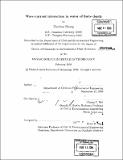Wave-current interaction in water of finite depth
Author(s)
Huang, Zhenhua, 1967-
DownloadFull printable version (10.72Mb)
Other Contributors
Massachusetts Institute of Technology. Dept. of Civil and Environmental Engineering.
Advisor
Chiang C. Mei.
Terms of use
Metadata
Show full item recordAbstract
In this thesis, the nonlinear interaction of waves and current in water of finite depth is studied. Wind is not included. In the first part, a 2D theory for the wave effect on a turbulent current over rough or smooth bottom is presented. The logarithmic profile of the basic current is modified by the waves due to an effective mean shear stress on the free surface. Surface distortion of the eddy viscosity is shown to be important for the change of the mean velocity profile by waves. Both wave-following and wave-opposing current are studied. Comparisons are made with some existing laboratory experiments. In the second part, an instability theory is presented for the initiation of Langmuir cells due to waves interacting with a turbulent current maintained by tides or by an external pressure gradient. With an infinitesimal span-wise disturbance, the free surface experiences a new mean stress, which generates new vorticity to be diffused downward, and induces further growth. Various contributions to the unstable growth of Langmuir circulation are analyzed by examining the mechanical energy budget. Evidences will be shown that the surface stress contributes significantly to instability. Both wave-following current and wave-opposing current are studied. For the wave-following current, two types of Langmuir cells can grow in time; while for the wave-opposing current, only one can grow. Effects of current strength, wave conditions, and water depth on the growth of Langmuir circulation will be studied by numerical examples. Remarks on existing laboratory experiments are made
Description
Thesis (Ph. D. in Environmental Fluid Mechanics)--Massachusetts Institute of Technology, Dept. of Civil and Environmental Engineering, 2004. Includes bibliographical references (p. 263-269).
Date issued
2004Department
Massachusetts Institute of Technology. Department of Civil and Environmental EngineeringPublisher
Massachusetts Institute of Technology
Keywords
Civil and Environmental Engineering.